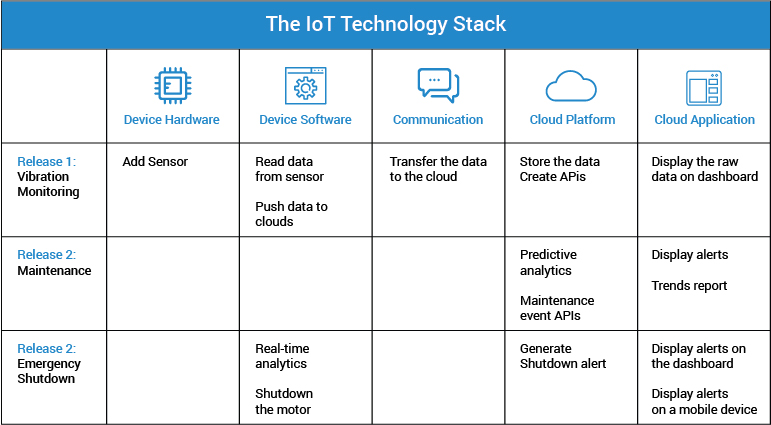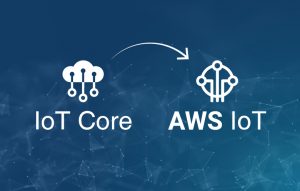Introduction
“The Internet of Things”, the term coined by British entrepreneur, Kevin Ashton in 1999 is defined as the network of physical devices, equipped with electronics, sensors, actuators, connectivity devices, protocols and a software to capture and monitor data. Since then the technology has come a long way down the road and has become a crucial driver for innovation, data-driven optimization & automation, the digital transformation of business models, and revenue streams for every industry.
However, implementation of IoT in a business is not an easy task. An IoT product is a complex system in itself. To have a smooth functioning solution, every layer of IoT technology stack – device hardware, software, communications, connectivity, cloud platform, and cloud applications – should be on the same page and need to work cooperatively. To manage a single IoT product is similar to deal with six products of different technologies simultaneously.
Why businesses need an IoT product roadmap
A roadmap can be defined as the game plan or the blueprint designed to make any product or strategy successful in the domain. With that in mind, let’s try to figure out, our question, what is an IoT product roadmap?
An IoT product roadmap is the action plan prepared to keep certain challenges faced by businesses who want to implement IoT in its process. The roadmap helps businesses to come up with solutions that can elevate the value proposition of the product.
Nevertheless, generating a precise IoT product roadmap is not an easy task. The design and development team have to synchronize every element of IoT technology stack with situations and scenarios that are to be taken into consideration. Apart from the technical perspective, there are some business challenges which are to be taken care of by stakeholders.
Below are some of the considerations that stakeholders have to keep in mind while designing an IoT product roadmap;
Synchronization of every layer of IoT technology stack
As said an IoT product is a combination of different technologies working together at different layers of IoT technology stack. In order to have a to-the-point IoT product roadmap, the layers of the stack shall be properly coordinated with the task for which the solution was developed in the first place.
User Experience (UX)
The ultimate goal of an IoT product is to deliver the best possible result to the end user. However, to achieve the optimum result, teams must come up with perfect permutation and combination of hardware, software, communication, cloud platform, and cloud application.
Data capture
For any IoT product, data is the king. Collection of relevant data and measurement of accurate KPIs is something the development team has to take care of while designing the roadmap for an IoT product.
Business opportunities
While designing the roadmap, teams have to think of the market that is to be targeted for a particular IoT product. Is there any demand for a particular product? Will it solve the purpose for which it is being developed? And most importantly, will it be accepted by the market? Similar questions always keep the business heads occupied in order to have a successful IoT product roadmap.
Security
It’s understandable that an IoT product is a bit expensive than any other product. Any, security threat to the product could cost a handsome amount to both – the user and the developer.
Standards and regulation
No matter how unique and helpful an IoT product is, it’s of no use if it doesn’t comply with the standards and regulations set by the governing body. While designing an IoT product roadmap, the company has to keep the product in between the demands of the client and the compliance laws.
How to create an IoT product roadmap
Let’s have a look at an example to understand how one can have an optimal IoT product roadmap.
Imagine a car manufacturer, who has just launched a new model in the market. The car is equipped with the latest engine, eye-catching interiors, luxurious upholstery, and all the premium functionalities that a car can have. In other words, the car is something that one cannot resist. However, the manufacturer wants that even before a customer registers a complaint or starts facing issues with any of the parts in the car, the company can reach out to the customers and fix it.
In order to be a step ahead of its customers, the manufacturer calls the technical team and discusses the plan that can do the job for them. They take every situation that might occur to the customer’s car into consideration and deduce a solution for each such situation. And finally, decide to implant sensors in every car so that each of them can be monitored regularly.
As we can see here that “predictive analytics” is what is being discussed here. However, it is very difficult for the stakeholders –Sales, Marketing, and Engineering department- to understand what can be done to achieve this functionality in the final product.
For an IoT product roadmap to portrait the entire picture, try to story map the IoT technology stack with the features of the final IoT product.
This results in visualization which gives enough information to the stakeholders to understand the big picture.
Now let’s see how it would look like when you visualize the roadmap.

As we notice, not every layer in the stack has to be affected on every single release and there are no further features in the communication layer, which implies that a single communication protocol can be used for every sensor installed in the car.
The above-mentioned table gives the detail of one of many functions that can be monitored in a car. However, a roadmap for other functionalities can be plotted easily in the same manner.
How an IoT product roadmap is helping a business to overcome the odds
Increased customer experience
An IoT product roadmap helps businesses to have a precise insight of what customers want and what their product is capable of delivering. This, in turn, helps the company to fulfil the customer expectation increasing the customer experience.
Extensive business opportunities
The roadmap provides a broad perspective of market’s demand providing huge business opportunities.
Relevant data capture
The company can have a pinpoint idea of which KPIs are to be measured and which parameters to look for during the monitoring of the data. This allows companies to capture relevant data and provide actionable insights.
Demystify the complexities
An IoT product roadmap helps businesses to understand the complexities involved in developing an IoT solution. This allows them to work and research on the targeted points to have an optimal IoT solution.
Better decision making
The overall process of plotting the IoT product roadmap helps the business to select the best combination of hardware, software, communication and cloud platform improving its decision-making capability.
Bottom line
As an IoT development and consulting company, one is bound to face challenges in communicating the product vision with every department of the company. It’s a difficult task and yet it is probably the most important function of our role. An IoT product roadmap provides an important and powerful communication tool one can use to express and illustrate the product ideas with the stakeholders.








